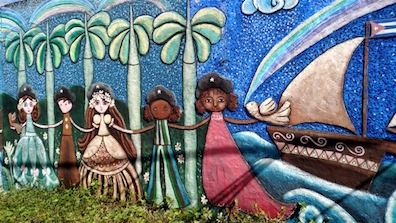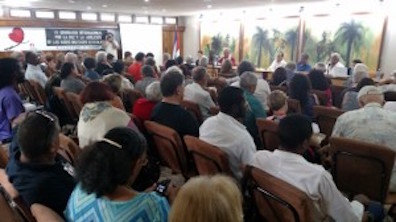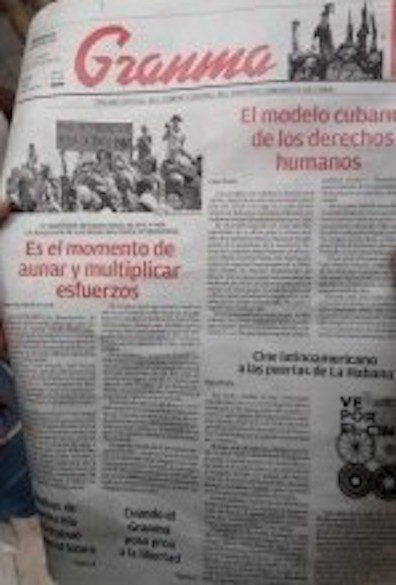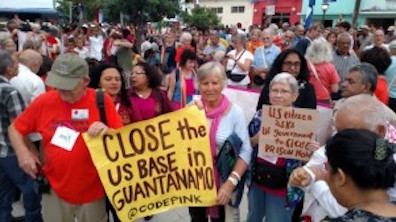Internationalizing Movements: Peace Delegation To Cuba
 Print This Print This
By Mackenzie McDonald Wilkins, Popular Resistance
Popular Resistance
Thursday, Dec 17, 2015
 |
| Above photo: Mural at the Cuban Institute for Peace. By Mackenzie McDonald Wilkins (MMW). |
From November 20-29, I was on the CODEPINK Peace Delegation to Cuba. The CODEPINK delegation included people from Iran, Colombia, Venezuela, Nicaragua, Guatemala, El Salvador, the United States and more. Other groups like Mexico’s National Movement for People’s Power (MNPP), the Canadian-Cuban Friendship Association, and Witness Against Torture organized parallel delegations that, in total, brought people from at least 33 countries to Cuba.
 |
| When we arrived on the evening of November 20th, hundreds of Cubans crowded the airport exit, waiting to greet their loved ones, many who were returning to Cuba for the first time in years. MMW. |
Most people from these delegations flew into the Capitol City of Havana and then bused or flew across the island to Guantanamo, Cuba’s easternmost province. Here, we attended the Fourth International Seminar for Peace and the Abolition of Foreign Military Bases, visited the town of Caimanera that borders the US Naval Base and prison, and protested at the base. Many of us also participated in a 24-hour Thanksgiving Day fast in solidarity with prisoners in Guantanamo who have been on hunger strike to protest their unjust incarceration. After four days in Guantanamo, we got back on the buses and returned to Havana.
Along the bus route, we stopped in towns like Santa Clara, Camaguey, Holguin, and Cienfuegos to learn about the history of each area and its role in the Cuban revolution. We visited the Che Guevara monument and museum in Santa Clara, walked through Fidel Castro’s childhood home in Biran, and met with Cubans working to maintain the revolution in the face of US imperialism. We spent hours driving through the verdant beauty of the Cuban countryside where sugar cane, grown for export, is still the main crop. This gave me some time to reflect on my experiences in Cuba.
 |
| At the Seminar for Peace. MMW. |
International Seminar for Peace and the Abolition of Foreign Military Bases
In the middle of the delegation we took a break from travel to attend the Peace Seminar in the town of Guantanamo. The seminar itself was excellent with over 200 participants and speakers from around the world. Anne Wright from CODEPINK spoke about the more than 70 US military bases in Latin America. Professor Mario Montero of Guantanamo spoke about the ecological impacts of the US Naval base in Guantanamo. Daniela Gonzalez Lopez from MNPP spoke about structural reforms and militarization in Mexico. Dennis Apel from the Global Network Against Weapons and Nuclear Power in Space spoke about the US military base and ICBM testing in the Marshall Islands. James Jordan of Alliance for Global Justice spoke about US prisons around the world. Others spoke about the peace talks in Colombia, Palestine solidarity, US bases in Japan and Jeju Island, and more. The United States has over 800 foreign military bases, each with their own story of social and ecological harm to the area, so there was a lot to discuss.
 |
| Seminar for Peace made Cuba’s main newspapers every day. MMW. |
The seminary called for the immediate closure of the Guantanamo base and prison, cleanup of the ecological damage caused by US activities on the base, and the return of the bay to the people of Cuba. We also called for an end to US terrorism and the economic blockade against the Cuban people. These problems, rooted in more than a century of US colonization of the Island, persist despite the historic restoration of diplomatic relations over the last year.
Guantanamo: More than a Base and Prison
On the first night of the seminar we attended a dance performance titled “My Guantanamo, Not the Naval Base.” The performance, put on by Guantanamo’s music and dance academy, highlighted the rich music and dance traditions of Eastern Cuba. Folkloric dances mixed into son, salsa, jazz, and modern dance styles. The event was overtly political with anti-imperialist spoken word poetry and songs. Even the dances, said one speaker, are a form of resistance.
The performance was a celebration of the people that live in Guantanamo. One speaker said “when people from other countries think about Guantanamo, they think about the military base. But this is where we live and where our cultures thrive.” After the show a few of us met up with the dancers, most of whom were teenagers, and the teachers. They invited us to visit their dance school, one of the best in the country.
 |
| Talking with students in the Guantanamo music and dance academy. MMW |
A couple of days later, nine of us took bicycle taxis to the school. We spoke to an elementary, middle school, and high school class about our own music and dance traditions, the seminar, and our lives. The students were politically savvy and could talk about the CIA in Cuba, the military base, and the embargo. They proudly showed us around and took us to the dormitories where kids whose families live further away sleep during the school week.
Then we met with the teachers. They were surprised to hear about some of the problems in US and Mexico schools that we talked about. They said there is little violence in Cuban schools, no police officers, an optional second school system for the differently-abled, and a lot of community engagement. In Cuba, schools get more money (as percent of GDP) than any other country in the hemisphere and teaching is one of the best paid professions. Like all schools in Cuba (including higher education), the Guantanamo music and dance academy is free.
We walked out of the meeting and, to our amazement, the whole school was gathered and waiting for us. A young girl read a statement against the military base and embargo and then the students put on a full dance performance right there in the school!
 |
| Dancer at the Guantanamo Music and Dance Academy. MMW |
Music, dance, and celebration surrounded the delegation and weave through all aspects of life for many Cubans. People play music and dance in the streets, in restaurants, in their homes, and at school (not just dance schools). Shortly after we left the dance school, we hopped back in the buses and headed, through two military checkpoints, to Caimanera, a town that borders the US Naval base on the Guantanamo Bay. As we drove into town, hundreds of people lined the street waving to us for miles and even more greeted us at our final destination.
We heard a presentation from the municipal authorities, went to high ground to look over the base, and then ended with a celebration in the town center with people from over thirty countries. The final declaration from the Seminar was read and we all chanted “Viva La Paz,” “Long live Peace!” Then, the Caimanera dance school and the local brass band performed and we all danced together.
Caimanera and the Base
Not far from our celebration loomed the 117 square kilometer US Naval base. For some US Marines and Navy Personnel the Guantanamo base is a tropical paradise with golf courses, tennis courts, archery ranges, open air movie theaters, jet skiing, scuba diving with thousands of fish species in the coral reefs, a McDonalds and a Starbucks.
Behind this veil of wealth and privilege lays immense pain and suffering, the reality of most US bases. For many Marines, the base is an abusive place with sexual assault, physical abuse, and hazing. For political prisoners it is hell. There are 107 prisoners still being held and tortured in the Guantanamo prison. Many have been caged for over a decade without convictions. On December 2, US officials admitted that 37-year-old Mustafa al-Aziz al-Shamiri was captured because of a mistaken identity. He is still being held. Read more on the prison here.
 |
| Delegates at the celebration in Caimanera. MMW |
For the province of Guantanamo and towns near the base like Caimanera, the base is an assault on sovereignty, an economic leech, and a violent occupier of the land and bay. Caimanera is one of two towns that sit adjacent to the base on the northern portion of the Guantanamo Bay. The base lies directly south of Caimanera, cutting the town off from the southern portion of the bay that opens to the Caribbean Sea. Caimanera, therefore, has no access to the ocean or the port despite living on one of Cuba’s deepest bays.
For over a century, this has strangled the economy of Guantanamo and especially Caimanera. Any imports to or exports from Caimanera have to be transported hundreds of miles across bumpy roads to and from other ports. Fisher women and men are confined to the northern bay where there are no longer enough fish to sustain the town. Others have worked in the nearby salt mines or in prostitution for marines. The base is surrounded by a wall, guard towers, and tens of thousands of Cuban and US antipersonnel and antitank land mines that were planted after the Cuban revolution. At least twenty people and innumerable animals have been blown up in these mine fields.
Other Cubans have been murdered by US soldiers. In 1961, a Cuban worker was beaten to death and a fisherman was kidnapped and killed. From 1964-1966 two Cuban soldiers were shot by US soldiers near the base. People living near the base live under the threat of invasion: US soldiers are known to fire shots or throw stones into Cuba and there have been many violations of Cuban air space, waters, and land.
The people of Caimanera almost unanimously oppose the base. That is why so many came to greet us when we visited the town. They live with it and fight against it every day, just like many people who were visiting for the first time. The international gathering in Caimanera, and the delegation as a whole, brought people together who believe in and yearn for a future of peace, empathy, and solidarity. Cuba, itself an experiment in anti-capitalism, was the perfect place to gather and sow these seeds of peace.
Cuba and US Empire
The US base in Guantanamo (along with the 70 other US bases in Latin America) is a “permanent threat to the peoples of Latin America,” said Maria de Socorro, President of the World Peace Council. Established in 1903, against the will of the Cuban people, it is the oldest US foreign military base. Speaking at the Seminar, Socorro said “military bases abroad are nothing but control mechanisms and reasons to loot with impunity natural resources such as gas, oil, or water.” Socorro and the whole of the Seminar denounced US foreign bases and demanded the return of the occupied territory in Guantanamo.
Meanwhile, the Obama administration is unwilling to close the prison, not to mention the whole base. Obama recently rejected the Pentagon draft plan to move the prison to the United States, saying it is too expensive. Clearly, Obama’s campaign promises were a cover up for his military industry ties. With the immense power of arms manufacturers and defense contractors, we can’t rely on political elites to close bases, end corporate globalization, and dismantle the empire. This will only be done by a massive international movement that takes on white supremacy, capitalism, and the empire as a whole.
 |
| Protest at the US Embassy in Havana. MMW |
Cuba has the overwhelming support of the international community, especially in its fight against the US embargo that has caused immeasurable damage to people in Cuba. On October 27, 2015, the United Nations General Assembly voted almost unanimously to lift the blockade. The only countries opposed were the United States and Israel. The economic, commercial, and financial blockade has impeded access to life-saving medicines, food, investment, and thousands of goods and services. It has caused over $121 billion in losses to the Cuban economy.
Foreign Minister of Cuba, Bruno Rodriguez Parrilla says, “the blockade is a flagrant, massive and systematic violation of the human rights of all Cubans; it is contrary to International Law; it has been described as a crime of genocide by the Convention for the Prevention and Punishment of the Crime of Genocide of 1948 and is the main obstacle to the economic and social development of our people. The human damages it has caused are inestimable. Seventy seven per cent of all Cubans have been suffering the blockade since the day they were born. The shortages and deprivations that it causes to all Cuban families cannot be accounted for.”
In addition to the embargo and base, the United States (often working with Cuban exiles) has relentlessly tried to undermine and overthrow the Castro governments. There have been over 600 assassination attempts on Fidel Castro’s life. Raul Castro has also been targeted time and time again. Cuban’s don’t know where their comandante lives or where he will show up next. There have also been incredible propaganda campaigns in Cuba. Recently, USAID created a fake twitter platform to fuel opposition to the revolutionary government.
 |
| Old cars and buildings in Havana. MMW |
The Castro Governments
Under these circumstances, the Cuban government has done some remarkable things for people in Cuba and around the world. Cuba has free education at every level, free healthcare, excellent environmental protections, very little income inequality, guaranteed housing and work, and the lowest homeless and unemployment rates in the hemisphere. Most of the food that Cuba grows today is organic and the food ration system means that no one goes hungry. Compared to neoliberal countries in the Americas where multinational corporations and their military forces rape and pillage with no remorse, Cuba sounds utterly utopian.
But there is no such thing as a perfect government, particularly in a world of unrelenting capitalism and violent empire. Cuba is no exception and the government has been criticized by the left, especially for its suppression of free speech. Co-founder of CODEPINK Medea Benjamin, for instance, was deported from the country after criticizing the government. In a recent interview Benjamin said, “even though the blockade was used always as an excuse of why we can’t have more free speech, I felt that there should have been more of an open, democratic society in Cuba, and that while Fidel Castro was an incredible leader of having made the revolution, that I believe in renewal of leadership constantly, and that that wasn’t happening in Cuba.” Years later, Fidel Castro personally apologized to Benjamin and she has been allowed, now with large CODEPINK delegations, back into the country.
This doesn’t mean, however, that the problems have been addressed. Despite anti-racism measures in the government, racism lives on, and suppression of free speech is still a problem, like in any government. Many Cubans I talked to pointed out the problems, but still defended their government, blaming the United States instead. How is the Cuban government supposed to act when the CIA and USAID are running all over the island trying to foment counterrevolution, they asked. The United States and its corporate media have blown up human rights abuses in Cuba which pale in comparison to its own. Today, Raul Castro is finding new ways to deal with human rights violation in Cuba and has released many political prisoners.
International Solidarity:
For a small island nation, continuously beaten down by the US, Cuba has an amazing history of reaching beyond its borders. With one of the best health education systems of any country, Cuba is known for sending doctors, not troops, around the world. Cuban doctors served on the battlefields of the Vietnam War, were the first to respond to the Ebola emergency in West Africa, and had the largest international medical contingent in Haiti after the devastating earthquake. “In the aftermath of the Kashmir earthquake of 2005,” says Seumas Milne, “Cuba sent 2,400 medical workers to Pakistan and treated more than 70% of those affected; they also left behind 32 field hospitals and donated a thousand medical scholarships.” Canadian professor John Kirk says “Cuban medical internationalism has saved millions of lives.”
Before the collapse of the Soviet Union, Cuba maintained enough military forces to support people fighting against powerful oppressors in other countries. In 1973, “Fidel dispatched a 1,500-man tank division to fight alongside Syria against Israel.” Later in the 1970s and 1980s Cuba was the only country to join Angola in the fight against US backed apartheid forces from Zaire and South Africa. As Matt Peppe describes, “Cuba’s intervention in Angola managed to change the course of that country and reverberate throughout Africa. By ensuring independence from the white supremacists, Angola was able to preserve its own revolution and maintain its role as a base for armed resistance groups fighting for liberation in nearby countries.”
Nelson Mandela was in jail in 1975 when he learned about Cuban troops in Angola. He wrote that this was the “first time that a country had come from another continent not to take something away, but to help Africans to achieve their freedom.” Cuba’s role in the region was critical to the fall of apartheid in South Africa. Historian Piero Gleijeses says that Cuba’s internationalism is unprecedented: “no other Third World country has projected its military power beyond its immediate neighborhood.” Read more here.
Delegations like this one to Cuba are a way to build relationships (and solidarity if there is meaningful follow up) with people in other countries and around the world. We each have our own local struggles, but in the twenty-first century, these are tied into a global system of racism, capitalism, and empire. To challenge corporations and banks that easily move across nation state borders (especially under “free trade” agreements like the pending TransPacific Partnership) our movements also need to be internationalized—borders were created to divide us and they must be brought down. In the United States, the source of so much devastation in other countries, we have a particular responsibility to engage in solidarity work.
Source URL
|
 Print This Print This

|

